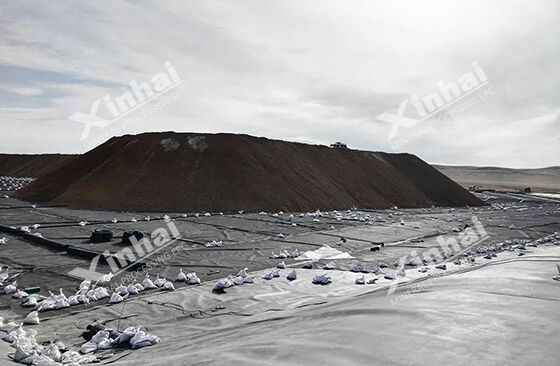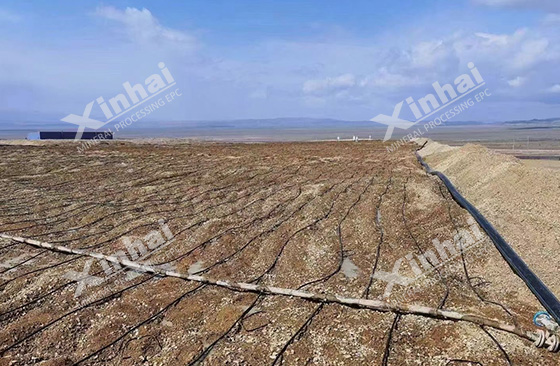
Gold ore heap leaching is a common processing method for gold ore beneficiation. It is widely used in beneficiation plants due to its advantages of large production scale and low production cost. The heap leaching process is generally divided into: ore preparation, heap leaching site construction, heap building, percolation leaching, heap washing and unloading, and gold recovery. The following will give you a detailed introduction to the heap leaching process.

The gold-bearing ore extracted from the mining field needs to be crushed, and the crushing particle size is determined according to the nature of the ore and the embedded particle size of the gold particles. During heap leaching, the finer the ore particle size, the looser and more porous the ore structure can increase the leaching rate of ore gold and shorten the leaching time. However, the particle size of the heap leaching ore should also be controlled. If the particle size is too fine, the percolation and leaching speed will slow down, which will seriously affect the leaching of gold particles.
Heap leaching sites are generally built on hillsides, valleys or flat land, and the slope requirement is generally 3%-5%. Use various construction machinery to clean and level the bottom surface of the heap leaching site, and then carry out anti-seepage treatment. The anti-seepage material can be tailings mixed with clay, asphalt, reinforced concrete, rubber sheet, etc. First, the ground is compacted or tamped, and then a plastic film or a high-strength polyethylene sheet is laid on it to ensure that the anti-seepage layer does not leak and can withstand the pressure of the pile. In order to protect the anti-seepage layer, 0.5-2.0m thick coarse-grained waste rock is laid on the cushion layer.

Heap leach sites can be single-use or multiple-use. If the heap leach site is for one-time use, a layer of clay with a thickness of 0.5m shall be laid on the cushion layer. The heap leaching site is equipped with a collecting ditch to collect precious liquid. A liquid collection tank is set at one corner of the heap leaching site to settle the ore sludge, and the precious liquid entering the precious liquid pool can be called clarified solution. Flood drainage ditches or flood retaining walls should be set up around the storage yard to prevent flooding of the storage yard.
Use trucks, bulldozers and other stacking machines to stack the crushed ore at one time. Heap height, length, height and time should be determined according to ore properties and ore particle size. After the stacking is completed, use the stacking machine to push away the hardened layer around, level the surface, and pull trenches on the surface of the stacking yard in turn to enhance the permeability of the spray liquid.

After the pile is completed, sprinkler pipes are arranged on the surface of the pile. The main sprinkler pipe is made of seamless steel pipes, the branch pipes are made of plastic pipes, and the top of the storage yard is made of swinging sprinklers. Control the distance between the spray branch pipe and the sprinkler head. If the nozzle has calcification, it can be cleaned with 5% salt water. When spraying, the spray intensity and spray volume can be appropriately increased to increase the gold leaching rate. After spraying for a period of time, the amount and time of spraying should be controlled.
After the expensive heap leaching solution is settled and clarified in the rich solution pool, it is adsorbed by the adsorption tank. After the adsorption, the gold-loaded carbon is desorbed, and the precious liquid is electrolyzed to obtain the gold concentrate.

After the spraying, there is a certain amount of cyanide ions and leached free gold in the stockyard. Direct unloading will cause the loss of gold and affect the environment, so it is necessary to wash the pile. When washing the pile, generally use industrial water with a pH value of about 8-10 for continuous spraying to detect the cyanide ion and gold grade in the site. Generally, the spraying time is controlled at 2-3 hours. Heap washing can be stopped when the root ion is less than 0.2 x 10-4 and the gold grade is less than 0.1g/m3. After the washing liquid is exhausted, the pile can be unloaded. When unloading, leave a layer of waste slag 2m thick at the bottom of the yard to avoid damage to the bottom pad.
The above is the gold ore heap leaching process. In actual production, there are factors that affect the heap leaching effect in each process, such as the height of the heap, the concentration of cyanide, and the leaching time. Therefore, it is necessary to design the heap leaching process according to the actual situation. Xinhai Mining recommends beneficiation test, and the design of beneficiation process according to the nature of ore can guarantee the leaching rate of gold, shorten the production time and improve economic benefits.
To find out more about our products and solutions, please fill out the form below and one of our experts will get back to you shortly.